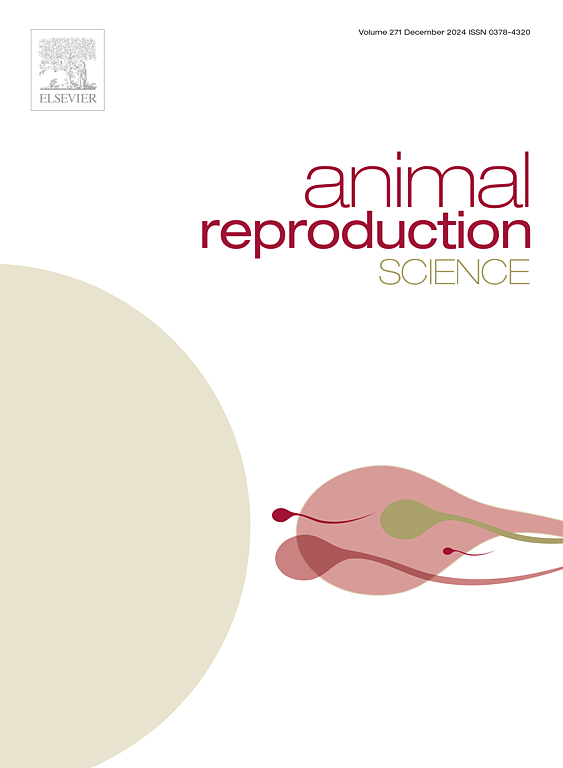家禽精子适应性评估:体外方法综述。
IF 2.2
2区 农林科学
Q1 AGRICULTURE, DAIRY & ANIMAL SCIENCE
引用次数: 0
摘要
在家禽业中,生产的每只小鸡或家禽都具有很高的经济价值;因此,选择能够将理想性状传递给后代的雄性育种者对繁殖和孵化成功具有重要作用。在自然交配或人工授精之后,精子必须经过一系列步骤才能使卵子受精。从沉积部位(阴道)到精子储存管(SST);2. 进入并停留在海温区内;3. 再次搜取能动性;和4。结合并穿透卵。为了成功地完成这些任务,精子必须是活的、可运动的,并且具有结构完整性(膜、糖萼、顶体和DNA)。为了评估精子的适应性,可以进行几种体外测试;然而,通常有必要将几种检测方法结合起来,以获得更可靠的生育能力估计,因为每种方法评估的都是特定的和不同的精子特征。在本文中,我们简要回顾了可用于评估家禽精子的体外试验,并将它们与受精的每个步骤联系起来。精卵相互作用试验使用鸡蛋的内卵黄周层,因为它是一个单一的测试,评估多个精子的特征,并与生育能力高度相关。本文章由计算机程序翻译,如有差异,请以英文原文为准。
Sperm fitness assessment in poultry: Brief review of in vitro methods
In the poultry industry, every chick or poult produced has high economic value; therefore, selection of male breeders capable of transmitting desirable traits to their offspring has an important role in fertility and hatching success. Following either natural mating or artificial insemination, sperm must go through a sequence of steps to fertilize the egg: 1. Go from the site of deposition (vagina) to the Sperm Storage Tubules (SST); 2. Enter and stay inside the SST; 3. Reacquire motility; and 4. Bind to and penetrate the egg. To perform these tasks successfully, sperm must be alive, motile, and have structural integrity (membrane, glycocalyx, acrosome, and DNA). To evaluate sperm fitness, several in vitro tests can be performed; however, it is often necessary to combine several assays to have a more reliable fertility estimation, as each procedure evaluates specific and distinct sperm features. In this article, we briefly review in vitro tests that can be used to evaluate poultry sperm, associating them with each step for fertilization. The sperm-egg interaction assay using the inner perivitelline layer of chicken eggs is highlighted, since it is a single test that evaluates multiple sperm characteristics and is highly correlated with fertility.
求助全文
通过发布文献求助,成功后即可免费获取论文全文。
去求助
来源期刊

Animal Reproduction Science
农林科学-奶制品与动物科学
CiteScore
4.50
自引率
9.10%
发文量
136
审稿时长
54 days
期刊介绍:
Animal Reproduction Science publishes results from studies relating to reproduction and fertility in animals. This includes both fundamental research and applied studies, including management practices that increase our understanding of the biology and manipulation of reproduction. Manuscripts should go into depth in the mechanisms involved in the research reported, rather than a give a mere description of findings. The focus is on animals that are useful to humans including food- and fibre-producing; companion/recreational; captive; and endangered species including zoo animals, but excluding laboratory animals unless the results of the study provide new information that impacts the basic understanding of the biology or manipulation of reproduction.
The journal''s scope includes the study of reproductive physiology and endocrinology, reproductive cycles, natural and artificial control of reproduction, preservation and use of gametes and embryos, pregnancy and parturition, infertility and sterility, diagnostic and therapeutic techniques.
The Editorial Board of Animal Reproduction Science has decided not to publish papers in which there is an exclusive examination of the in vitro development of oocytes and embryos; however, there will be consideration of papers that include in vitro studies where the source of the oocytes and/or development of the embryos beyond the blastocyst stage is part of the experimental design.
 求助内容:
求助内容: 应助结果提醒方式:
应助结果提醒方式:


